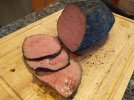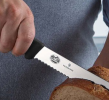I got a new TSPROF so just for fun I put a mirror edge on my Henkel carving knife. It's a paper-slider's dream.
I made a reverse sear roast beef today (holy crap it was good - pics below) and trying to cut it with this knife was laughable. I was sliding the knife back and forth on the crispy outside edge of the meat and it just wouldn't cut. I had to use ridiculous force to break through.
It's obviously the same phenomenon that it's easier to cust a raw tomato with a serrated knife than a smooth edge. The question is, how do I fix it? Do I just stop when I get to the medium-grit stones? Or should I throw out this knife and buy a serrated one?
I made a reverse sear roast beef today (holy crap it was good - pics below) and trying to cut it with this knife was laughable. I was sliding the knife back and forth on the crispy outside edge of the meat and it just wouldn't cut. I had to use ridiculous force to break through.
It's obviously the same phenomenon that it's easier to cust a raw tomato with a serrated knife than a smooth edge. The question is, how do I fix it? Do I just stop when I get to the medium-grit stones? Or should I throw out this knife and buy a serrated one?




